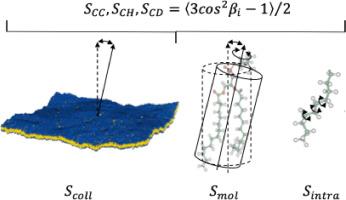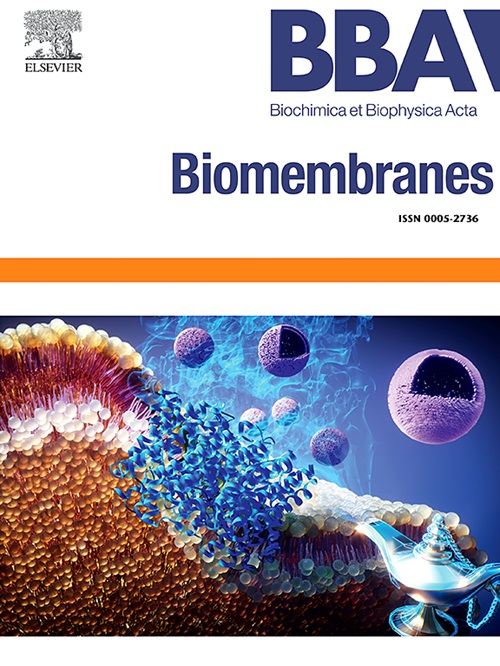膜中的有序参数:遵循Joachim Seelig的路径。
IF 2.5
3区 生物学
Q3 BIOCHEMISTRY & MOLECULAR BIOLOGY
引用次数: 0
摘要
随着20世纪70年代生物膜模型的发表,Joachim Seelig是第一个通过实验证明这些膜的动态特性的人。他进行了第一次ssNMR实验,测量了氘标记的脂质CD (2H)键的有序参数,显示出相当流体的膜内部。从那时起,CD, CH和CC键的有序参数被测量。它们可以用来描述膜在几个空间和时间尺度上的动力学:分子内(Å/ns-ps),分子(nm/1-100 ns)和集体(膜变形,μm/μs)。CD, CH, CC在膜双分子层上的顺序参数的轮廓使我们能够将脂质膜描述为在甘油和链水平上非常坚硬,在其中心和表面非常流动。这对于带有双键、环或支链甲基的脂链来说是正确的。跨越整个膜的双极脂质没有一个非常流体的膜内部。甾醇调节膜动力学,增加流体相的序参量,减少凝胶相的序参量。它们可以被描述为膜动力学的调节器,因为当环境因素(温度、pH等)发生变化时,它们使膜保持在动态状态,变化很小。用统计力学方法描述的有序参数可以精确计算链的长度、双层膜的厚度和膜的弹性常数。膜中各脂类的表面积也可由序参数平台(位置C3-C10)计算得到:AL=831-SCDplat。本文章由计算机程序翻译,如有差异,请以英文原文为准。

Order parameters in membranes: Following Joachim Seelig's path
Following the publication of biological membrane models in the 1970s, Joachim Seelig was the first to experimentally demonstrate the dynamic nature of these membranes. He conducted the first ssNMR experiments to measure the order parameters of the C![]() D (2H) bond of lipids deuterium-labelled, showing a fairly fluid membrane interior. Since then, the order parameters of the C
D (2H) bond of lipids deuterium-labelled, showing a fairly fluid membrane interior. Since then, the order parameters of the C![]() D, C
D, C![]() H and C
H and C![]() C bonds have been measured. They can be used to describe the dynamics of membranes on several space and time scales: intramolecular (Å/ns-ps), molecular (nm/ns–100 ns) and collective (membrane deformations, μm/μs). The profile of C
C bonds have been measured. They can be used to describe the dynamics of membranes on several space and time scales: intramolecular (Å/ns-ps), molecular (nm/ns–100 ns) and collective (membrane deformations, μm/μs). The profile of C![]() D, C
D, C![]() H, C
H, C![]() C order parameters across the membrane bilayer allows us to describe the lipid membrane as being very rigid at the glycerol and chain levels and very fluid at its center and surface. This is true for lipid chains carrying double bonds, rings or branched methyl groups. Bipolar lipids that span the entire membrane do not have a very fluid membrane interior. Sterols modulate membrane dynamics, increasing order parameters in the fluid phase and decreasing them in the gel phases. They can be described as regulators of membrane dynamics, as they maintain the membrane in a dynamic state that varies very little when environmental factors change (temperature, pH, etc.). The description of order parameters by statistical mechanics allows the length of the chains, the thickness of the bilayer and the membrane elastic constants to be calculated accurately. The surface area of each lipid in the membrane can also be calculated from the plateau of order parameters (positions C3-C10): .
C order parameters across the membrane bilayer allows us to describe the lipid membrane as being very rigid at the glycerol and chain levels and very fluid at its center and surface. This is true for lipid chains carrying double bonds, rings or branched methyl groups. Bipolar lipids that span the entire membrane do not have a very fluid membrane interior. Sterols modulate membrane dynamics, increasing order parameters in the fluid phase and decreasing them in the gel phases. They can be described as regulators of membrane dynamics, as they maintain the membrane in a dynamic state that varies very little when environmental factors change (temperature, pH, etc.). The description of order parameters by statistical mechanics allows the length of the chains, the thickness of the bilayer and the membrane elastic constants to be calculated accurately. The surface area of each lipid in the membrane can also be calculated from the plateau of order parameters (positions C3-C10): .
求助全文
通过发布文献求助,成功后即可免费获取论文全文。
去求助
来源期刊

Biochimica et biophysica acta. Biomembranes
生物-生化与分子生物学
CiteScore
8.20
自引率
5.90%
发文量
175
审稿时长
2.3 months
期刊介绍:
BBA Biomembranes has its main focus on membrane structure, function and biomolecular organization, membrane proteins, receptors, channels and anchors, fluidity and composition, model membranes and liposomes, membrane surface studies and ligand interactions, transport studies, and membrane dynamics.
 求助内容:
求助内容: 应助结果提醒方式:
应助结果提醒方式:


